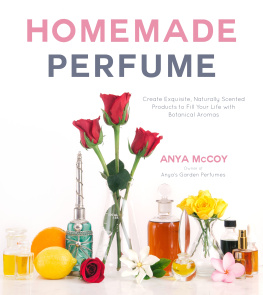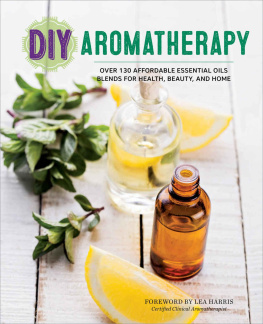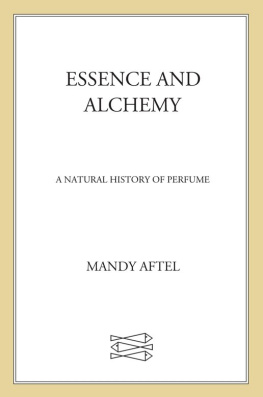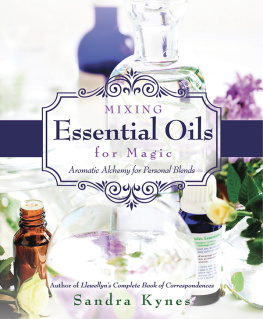Introduction to
Artisan Perfumery
Angie Andriot
Alyssa Middleton
Beauty From Ashes Press
Louisville, KY
2014 Angie Andriot and Alyssa Middleton
All rights reserved. No portion of this book may be used without sole permission of the copyright holder except in use of a review. For permission, contact permission@bathandbodyacademy.com.
Published by Beauty for Ashes Press
DISCLAIMER
The authors and publishers of this book and the accompanying materials have used their best efforts in preparing this book. The authors hope you enjoy the projects discussed in this book. While we believe the projects to be safe and fun, all such projects are done at the readers sole risk. The authors cannot accept any responsibility or liability for any damages, loss, or injury arising from use, misuse, or misconception of the information provided in this book. The information contained herein is strictly for educational purposes. If you wish to apply ideas contained in this book, you are taking full responsibility for your actions. The authors do not warrant the performance, effectiveness or applicability of any sites listed or linked to in this book. All links are for information purposes only and are not warranted for content, accuracy or any other implied or explicit purpose. The authors may have affiliate agreements with some of the websites linked to in this book and may receive compensation for purchases made through the affiliate link. ALL rights reserved. No part of this book may be copied or changed in any format, sold or used in any way, under any circumstances without express permission from:
Angela Andriot; aandriot@vetiveraromatics.com; AND
Alyssa Middleton; Alyssa@bathandbodyacademy.com.
INTRODUCTION
Welcome, thank you and congratulations on purchasing this book. You are now on your way to learning how to make a variety of perfumes as well as unique aromatic formulas. In this book you will learn about the ingredients used to make different types of perfumes including alcohol based, oil based and solid perfume. You'll learn to make your own scent blends using fragrance oils, essential oils or a combination of both. Step-by-step instructions make it easy for you to follow along. Included is also a resource directory so you can quickly and easily find the supplies needed to make and package your products. Although there is an abundance of bath and body supply companies throughout the country, those included in the directory are among the best weve found in all our years of regularly purchasing ingredients and supplies.
We hope you will enjoy making perfumes as much as we do. If you have any questions, comments or suggestions, we would love to hear from you. Please send all messages to help@bathandbodyacademy.com. If you purchased this book to develop products for your own bath and body company but need help developing a unique formula or need business consulting or coaching, we would be happy to assist you on your road to developing a thriving body care company.
As a special thank-you just to you for purchasing this Kindle book, you can access printable reference charts including Fragrance Oil Notes, Essential Oil Notes, Essential Oil Substitutions Chart, Carrier Oils and their Benefits, Dilution Rates and Concentration Amounts at:
http://www.BathandBodyAcademy.com/PerfumeryCharts
For additional instruction on perfumery, please visit: www.vetiveraromatics.com.
Please visit www.bathandbodyacademy.com/consulting to learn more about business consulting and coaching packages available to highly committed entrepreneurs.
HISTORY OF PERFUMERY
A h, the joys of mixing fragrances! When done right, perfume is more than a mere olfactory experience. It is a travel through time, a mythical adventure, an artistic masterpiece, and a (mad) scientists creation. In the end, perfume is about people. Its our connection to culture, tradition, history, mythology, spirituality, and by extension, each other. Mixing fragrances requires a dash of artistry, a splash of imagination, and a healthy dose of mad scientist. Embed this activity in the centuries-old craft of perfumery, and you have more than just a nice-smelling ointment; you have a little piece of creation made by your own hands. Plus, you have connected yourself to a rich and vast tradition of harnessing the power of scent.
The art of perfumery is over 4,000 years old, with roots tracing to Mesopotamia, Egypt and China. Although nowadays we think of perfume as a sublimely scented liquid we can apply to our skin, the word itself originated with the French, who coined the term parfum to describe the fragrant smoke obtained from burning aromatic substances. In fact, perfume comes from the Latin phrase per fumare, or through smoke. This early form of incense marks the first historical appearance of perfume.
Perfume originated as a deeply symbolic and often spiritual act. Frankincense, myrrh, and other aromatic woods and resins, were often burned as a part of religious rites. In fact, some cultures originally reserved the rights to burn incense as solely for the priesthood and higher officials. In Egypt, it wasnt until the Golden Age that perfume was released to the masses; before that it was only used in rituals honoring the gods and pharaohs. The early Catholic Church had similar rules about the burning of certain incenses, viewing such an act a sacrament.
It wasnt long before people realized that these fragrances also did a nice job of covering foul odors, which were plentiful back in the days before indoor plumbing and regular bathing. The next stage in the evolution of perfumery was to use fragrances not to cover ones own scent, but to block the scents of others. In fact, upper class folks would wear specially scented gloves when venturing into town so as to inhale the scent of the glove instead of those around them. From this practice grew scented handkerchiefs, necklaces and lockets, and eventually perfume.
PERFUME INGREDIENTS
Perfume can be made in a variety of ways. In this section, we cover the most common ingredients used in the creation of perfume. We examine their strengths, weaknesses, and usefulness. Most simply, perfume is comprised of a fragrance and a base-the ingredient to which the fragrance is added. This is often referred to as the carrier because it carries the scent. A carrier is necessary because many fragrances are far too pungent and are sometimes even unsafe for direct skin contact. The carrier performs a triple function: dilute the scent, extend the fragrance, and protect the skin. The most common carriers are alcohol , oil and wax.
The second component of the perfume is the fragrance itself. A fragrance can come from natural sources such as essential oils and absolutes , or from synthetic sources such as fragrance oils and aroma chemicals. Some people have strong opinions about the use of natural versus synthetic products in their perfume. Others have strong opinions about what comprises natural to begin with. Here we cover all the ingredients, as well as the pros and cons, and leave it up to the reader to decide.
Aroma Chemicals
Most perfumes on the market today are made from a combination of natural and synthetic ingredients. The most basic form of ingredient is the aroma chemical. These are essentially, chemicals with smells, manufactured in a chemists lab, either through extraction, distillation , or synthesis.
The modern perfume chemist uses aroma materials from two main sources: crude oil, and isolates of essential oils. These can be nature identical, meaning the same chemical compounds can be found in nature, or they can be invented by humans.
Fragrance Oils
Fragrance oils are typically a combination of synthetic and natural substances. They can be distinguished from perfume oils, in that they are not diluted in an oil base. What we call fragrance oils and essential oils are often not oils at all, but rather a substance that simply has properties similar to oil. As such, one way to test whether the fragrance oils you have purchased are actually perfume oils is to try to mix them with alcohol. Since oil and alcohol dont mix, then you have a simple way to test whether your oils have actual oil in them.
Next page





